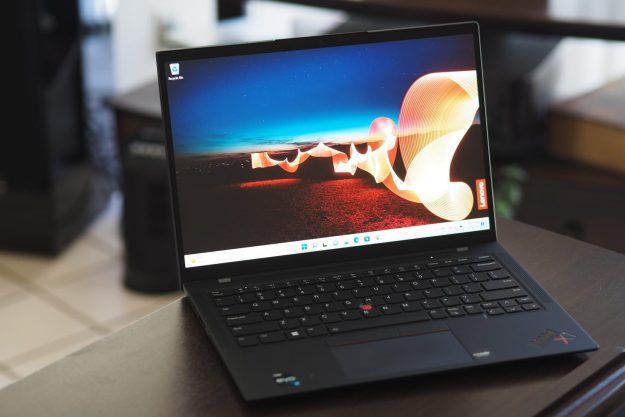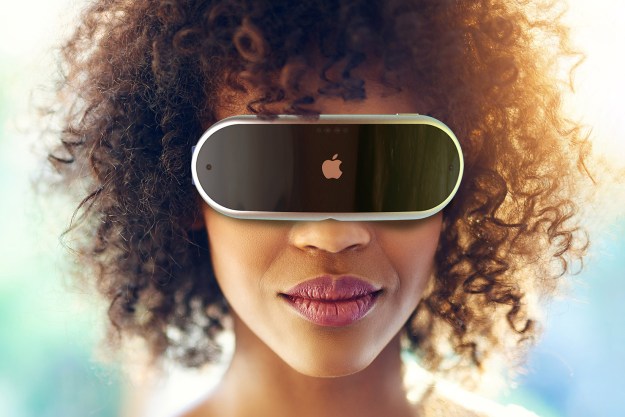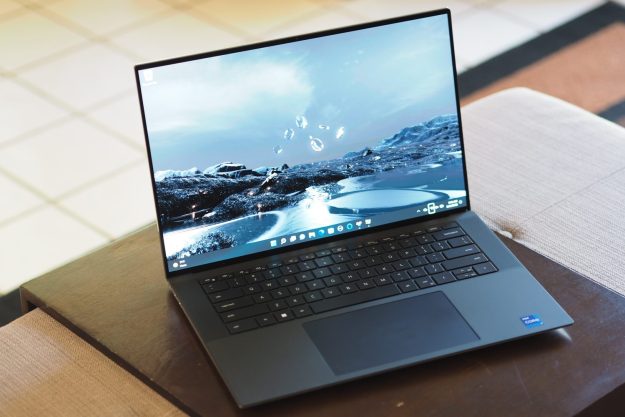
“The Dell XPS 15 is at the top of its game and remains the best 15-inch laptop you can buy.”
- Streamlined and solid build
- Aesthetically perfect
- Strong productivity and creative performance
- Above-average battery life
- Excellent keyboard and touchpad
- Superior OLED display
- Outstanding audio
- Expensive
- Performance ceiling limited by thin chassis
We rated Dell’s XPS 15 (9510) as the best 15-inch laptop you could buy. It offered the best combination of an attractive, well-built thin and light chassis, solid performance, and a spectacular 3.5K OLED display. Unless you needed workstation or gaming performance, the XPS 15 was the of its size you could buy. Now, Dell has released the XPS 15 (9520), which retains everything great about the previous model while updating to Intel’s 12th-gen platform.
I reviewed a midrange configuration of the XPS 15 with an Intel Core i7-12700H and the 3.5K OLED display. It runs $2,253, placing it solidly in premium laptop territory. After putting the laptop through its paces, I can say that it’s just as good as before, only faster.
It’s not the fastest 15-inch laptop you can buy (and I’ll include 16-inch laptops in the same class given the small differential in screen size). However, you’re getting a large laptop with a chassis that makes it seem much smaller than it is and enough performance to please all but the most demanding users. The XPS 15 retains its place as the king of 15-inchers.
Design
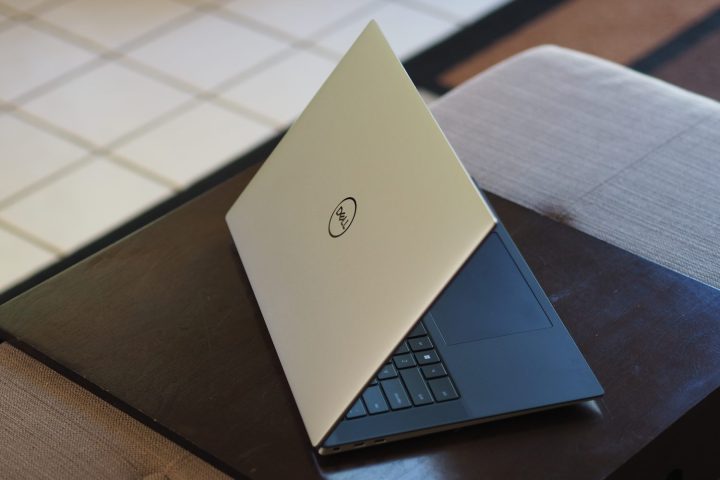
The XPS 15 benefits from years of design iterations that have culminated in a streamlined and cohesive aesthetic. The angles are just right, and the silver chassis with a black carbon fiber keyboard deck on my review unit is elegant without being ostentatious. You can also get a frost chassis with a white woven fiber keyboard deck that’s simply beautiful. In both cases, the keyboard deck is also warm and comfortable compared to bare metal.
The overall attention to detail is palpable and helps justify the laptop’s high price.
Each model has the same diamond-cut, double-anodized side edges that are attractive and functional, providing scratch resistance that helps keep the metal pristine despite plugging and unplugging peripherals. Thanks to the smallest display bezels you’ll find in a 15-inch laptop, which make up a 92.9% screen-to-body ratio, the XPS 15 looks ultra-modern with a screen that seems to float in the air. The only laptop that comes close to providing such an attractive design is HP’s Spectre x360 16, which is also more extravagant.
The design isn’t just aesthetically perfect. It’s also incredibly well-built, with no bending, flexing, or twisting in the lid, keyboard deck, or chassis bottom. Apple’s MacBooks Pros, Lenovo’s ThinkPads, and HP’s Spectres are as well-built, but few others can match the XPS 15. Even the hinge is well designed, with a dual-clutch mechanism that makes opening with one hand a breeze while holding the display firmly in place. The overall attention to detail is palpable and helps justify the laptop’s high price.
The XPS 15 is about as small as you can make a laptop with a 15.6-inch 16:10 display, thanks to the tiny bezels mentioned above. The Microsoft Surface Laptop 4 comes close, being almost as wide while being deeper thanks to its taller 15-inch 3:2 and larger bezels, but it’s not nearly as powerful. The XPS 15 is thin at 0.71 inches and light at 4.31 pounds, but the Surface Laptop 4 is thinner and lighter at 0.58 inches and 3.4 pounds.
We’ve seen more 16-inch laptops arriving with displays that are just slightly larger. The HP Spectre x360 16 is one such laptop, and it’s wider and deeper than the XPS 15 while being thicker at 0.78 inches and heavier at 4.45 pounds.
Ports
Connectivity is limited to three USB-C ports with Thunderbolt 4 support, a 3.5mm audio jack, and a full-size SD card reader. Dell includes a USB-C to USB-A and HDMI adapter, but the lack of legacy ports on the machine is disappointing and one of the costs of such a thin chassis.
Wireless connectivity is robust with Wi-Fi 6E and Bluetooth 5.2.
Performance
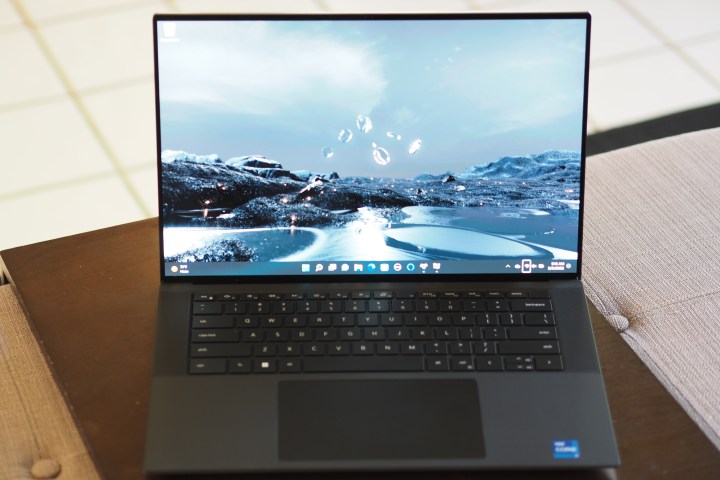
My review unit was equipped with the 12th-gen Intel Core i7-12700H, a 45-watt CPU with 14 cores (six Performance and eight Efficiency) and 20 threads. It’s been a solid performer in other laptops we’ve tested, most of which have been larger and/or thicker machines. Dell paid a lot of attention to thermal design with the XPS 15, using two fans and heat pipes along with hidden exhaust vents and a slight angle to increase airflow. Still, it’s a thin laptop that can only move so much air, and I was looking forward to seeing its Intel 12th-gen performance.
A quick note about performance modes. Given the prevalence of manufacturer utilities that allow the user to choose between modes that tune the fans and CPU speed to run cooler, more quietly, or faster, I’ve started reporting both “balanced” and “performance” mode benchmark results. You’ll see them reflected in the table. As you can see from the XPS 15 9520’s scores, switching to its performance mode made a significant difference in most of our benchmarks, particularly in its single-core performance. That’s different than the XPS 15 9510, which didn’t demonstrate a meaningful difference in performance mode in all but one benchmark.
The XPS 15’s thermal performance was predictable given the laptop’s size.
Overall, the XPS 15 9520 provided a meaningful bump in performance over the XPS 15 9510 with a 45-watt, 4-core/8-thread Core i7-11800H. It was 29% faster in Geekbench 5, 24% faster in performance mode in our Handbrake test that encodes a 420MB video as H.265, and 16% faster in Cinebench R23. Interestingly, it was slower in the PCMark 10 Complete benchmark that tests a variety of productivity, multimedia, and creative tasks.
Compared to laptops with the same CPU but thicker chassis and more robust thermal solutions, the XPS 15 9520 was a step behind. This was particularly true in balanced mode and with single-core tests. When looking at multi-core results, the XPS 15 9520 held its own against the Asus ZenBook Pro 14 Duo in Geekbench 5, Handbrake, and Cinebench. Against the Lenovo Legion 5i Pro gaming laptop and the MSI Creator Z17 in performance mode, the XPS 15 9520 caught up in its single-core scores but couldn’t keep up in multi-core. Its Handbrake result in performance mode was competitive, however.
| Geekbench (single / multi) |
Handbrake (seconds) |
Cinebench R23 (single / multi) |
PCMark 10 Complete |
|
| Dell XPS 15 9520 (Core i7-12700H) |
Bal: 1,470 / 9,952 Perf: 1,714 / 11,053 |
Bal: 100 Perf: 77 |
Bal: 1,509 / 11,578 Perf: 1,806 / 13,313 |
5,559 |
| Dell XPS 15 9510 (Core i7-11800H) |
Bal: 1,556 / 7,692 Perf: N/A |
Bal: 103 Perf: 101 |
Bal: 1,513 / 9,979 Perf: N/A |
6,024 |
| Asus ZenBook Pro 14 Duo (Core i7-12700H) |
Bal: 1,829 / 10,819 Perf: N/A |
Bal: 94 Perf: 82 |
Bal: 1,793 / 12,046 Perf: N/A |
6,242 |
| Lenovo Legion 5i Pro (Core i7-12700H) |
Bal: 1,625 / 11,543 Perf: 1,712 / 12,882 |
Bal: 72 Perf: 63 |
Bal: 1,725 / 14,135 Perf: 1,805 / 18,417 |
7,430 |
| MSI Creator Z17 (Core i7-12700H) |
Bal: 1,744 / 11,750 Perf: 1,741 / 13,523 |
Bal: 88 Perf: 70 |
Bal: 1,805 / 11,266 Perf: 1,819 / 15,754 |
6,951 |
| LG Gram 16 2-in-1 (Core i7-1260P) |
Bal: 1,682 / 9,035 Perf: 1,686 / 9,479 |
Bal: 137 Perf: 113 |
Bal: 1,524 / 6,314 Perf: 1,663 / 8,396 |
5,404 |
| Asus Zenbook S 13 OLED (Ryzen 7 6800U) |
Bal: 1,417 / 6,854 Perf: 1,404 / 7,223 |
Bal: 112 Perf: 111 |
Bal: 1,402 / 8,682 Perf: 1,409 / 8,860 |
5,647 |
I also ran the Pugetbench Premiere Pro benchmark that runs in a live version of Adobe Premiere Pro and uses discrete GPUs to accelerate various processes. We used an older version with the XPS 15 9510 and so can’t directly compare results with the XPS 15 9520. In the new version, the XPS 15 9520 with an Nvidia GeForce RTX 3050 Ti scored 760 in balanced mode and dropped to 729 in performance mode. That’s likely due to throttling (see below). These scores compare to the MSI Creator Z17 with the same CPU and an RTX 3070 Ti GPU that managed 897 and 984, respectively. We don’t have a laptop in our Pugetbench database with the same CPU and GPU as the XPS 15 9520, but the laptop’s scores are in line with expectations.
The XPS 15 9520’s thermal performance was predictable given the laptop’s thin chassis. I saw some throttling in our most intensive benchmarks, Handbrake, Cinebench, and Pugetbench, primarily when in performance mode. The CPU would hit its maximum temperature of 100 degrees Celcius periodically and then throttle, with the temperatures dropping into the 70s with reduced CPU frequencies. That process repeated itself in each test, which likely limited the performance ceiling. Performance mode was nevertheless effective in all benchmarks except Pugetbench. The fans spun up completely in performance mode but were surprisingly quiet and unobtrusive, and the keyboard deck and chassis never got more than warm.
I didn’t expect the fastest performance from the XPS 15 9520, and I didn’t get it. Instead, I got a laptop that’s impressively quick for being so thin and light. The XPS 15 9520 is more than fast enough for the most demanding productivity users while being reasonably speedy in creative tasks. If you’re a professional creator, you’ll want something thicker and with a faster GPU, but anyone else will find the XPS 15 9520 to be a compelling balance of size and speed.
| Assassin’s Creed Valhalla (1080p/1200p Ultra High) |
Civilization VI (1080p Ultra) |
Fortnite (1080p/1200p Epic) |
3DMark Time Spy |
|
| Dell XPS 15 9520 (RTX 3050 Ti) |
50 fps | 82 fps | 57 fps | Bal: 4,470 Perf: 4,520 |
| Dell XPS 15 9510 (RTX 3050 Ti) |
N/A | 61 fps | 50 fps | Bal: 4,540 Perf: N/A |
| Samsung Galaxy Book Odyssey (RTX 3050 Ti) |
15 fps | 61 fps | 54 fps | N/A |
| HP Spectre x360 16 (RTX 3050) |
N/A | 58 fps | 37 fps | Bal: 3,453 Perf: N/A |
| Lenovo IdeaPad Slim 7 16 Pro (RTX 3050) |
34 fps | N/A | 40 fps | Bal: 4,223 Perf: 4,878 |
| MSI Creator Z17 (RTX 3070 Ti) |
60 fps | N/A | 85 fps | Bal: 8,763 Perf: 9,263 |
The XPS 15 9520’s RTX 3050 Ti runs at 45 watts (80 watts is the chip’s maximum) and is clocked slower than the XPS 15 9510’s GPU. Therefore, the XPS 15 9520’s faster DDR5 RAM is offset by the slower GPU clock speed. Unsurprisingly, the newer machine’s 3DMark Time Spy test was lower than the previous model in balanced mode and essentially equal in performance mode.
Its performance in our benchmark titles was surprisingly good. For example, it hit 50 frames per second (fps) in Assassin’s Creed Valhalla at 1200p and ultra graphics, which is quite playable and only 10 fps behind the MSI Creator Z17 with an RTX 3070 Ti. In addition, it dropped only a bit to 46 fps at 1600p and ultra graphics. We didn’t run this benchmark on the XPS 15 9510. In Civilization VI, the XPS 15 9520 managed 82 fps at 1080p and ultra graphics, more than 20 fps faster than the XPS 15 9510, and 72 fps at 1440p and ultra graphics. Finally, in Fortnite, the XPS 15 9520 achieved 57 fps at 1200p and epic graphics. At 1600p and epic graphics, it hit 46 fps.
The RTX 3050 Ti is an entry-level GPU in and of itself, and simply put, the XPS 15 9520 wasn’t made to be a gaming laptop. Even so, the laptop was able to run our benchmark titles at 1080p/1200p and high graphics at decent framerates, and it was even playable at 1440p/1600p.
Display and audio
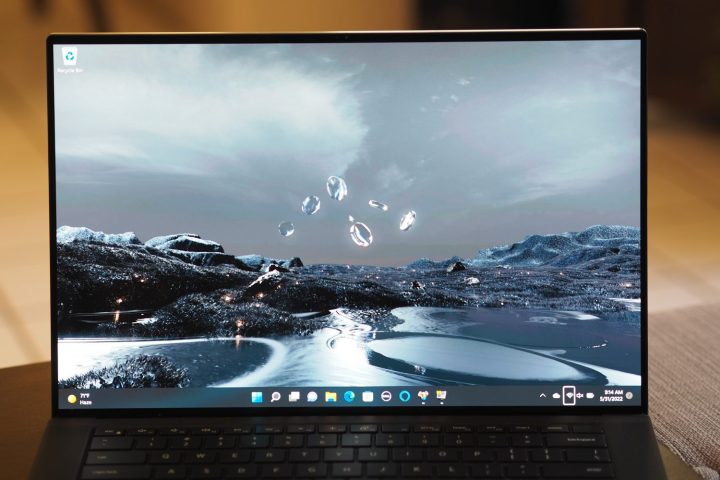
Dell offers three displays for the XPS 15 9520, all 15.6 inches in the productivity-friendly 16:10 aspect ratio. Options include Full HD+ (1920 x 1200) non-touch IPS, UHD+ (3840 x 2400) touch-enabled IPS, and 3.5K (3456 x 2160) touch-enabled OLED. My review unit equipped the latter, and it was bright and colorful out of the box with OLED’s typical inky blacks.
According to my colorimeter, the OLED panel was as good as always. The display was bright at 391 nits, well above our 300-nit threshold, so it’s visible in all but direct sunlight. The contrast ratio was incredibly high, creating inky blacks and text that pops on a white background. The colors were wide at 100% of sRGB and 96% of AdobeRGB and incredibly accurate with a DeltaE of 0.42 (1.0 or less is considered excellent). The Asus Vivobook 15 OLED and ZenBook Pro 14 Duo had slightly wider AdobeRGB gamuts but weren’t as accurate.
This is a gorgeous display for productivity and creative work that will please everyone.
I’ll note that I’m using a newer SpyderX colorimeter than the one used on the other OLED displays in our comparison group. It calculates OLED contrast differently from the previous models and returns lower scores. However, the contrast ratio is just as good despite the numerical difference in testing methods. To confirm, I tested with my older Spyder4 colorimeter, and it reported a contrast ratio of 392,140:1.
The only complaint with the display is that it’s not quite 4K+ resolution, which mostly impacts streaming video. Not that it really matters on a 15.6-inch display, where Netflix and other streaming content are quite enjoyable and benefit from great high dynamic range (HDR) support. This is a gorgeous display for productivity and creative work that will please everyone. If you demand 4K+ resolution, you can choose the high-res IPS option, which on past XPS 15’s has also provided wide and accurate colors, lots of brightness, and plenty of contrast (for an IPS display).
| Brightness (nits) |
Contrast | sRGB gamut | AdobeRGB gamut | Accuracy DeltaE (lower is better) |
|
| Dell XPS 15 9520 (OLED) |
391 | 28,130:1 | 100% | 96% | 0.42 |
| Lenovo IdeaPad Slim 7 16 Pro (IPS) |
420 | 1,310:1 | 100% | 77% | 1.59 |
| LG Gram 16 2-in-1 (IPS) |
323 | 1,230:1 | 100% | 87% | 2.82 |
| Asus Vivobook 15 OLED (OLED |
411 | 419,900:1 | 100% | 100% | 1.33 |
| Asus ZenBook Pro 14 Duo (OLED) |
345 | 344,480:1 | 100% | 100% | 1.18 |
The XPS 15 9520 has the same quad-speaker setup as the previous model, with two upward-firing speakers next to the keyboard and two speakers firing at an angle underneath the keyboard deck.
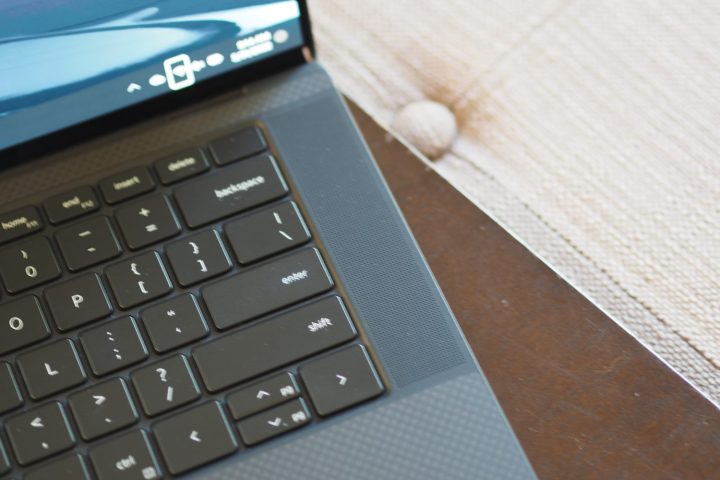
The audio system includes Waves NX 3D technology, and the speakers were tuned by Grammy Award winner Jack Joseph Puig. Does all that actually make a meaningful difference in sound quality? Absolutely. The XPS 15 9520 has some of the best audio in a Windows laptop, and it’s only clearly bested by the MacBook Pro. There’s tons of volume, mids and highs are detailed, and there’s some real bass. Listening to a movie trailer, there’s a noticeable 3D effect and a wider sound stage. Whether you’re gaming, bingeing Netflix, or listening to music, you’ll love the audio and won’t feel any need to pull out a pair of headphones.
Keyboard, touchpad, and webcam
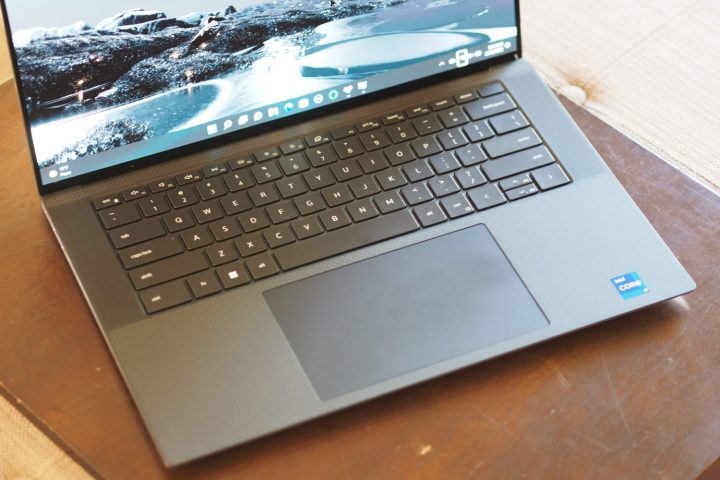
The XPS 15’s spacious keyboard doesn’t have the most travel, but its large keys enjoy light switches that are snappy and precise with a responsive bottoming action. It joins HP’s Spectre line in representing the best keyboards you can get on Windows laptops. Only Apple’s spectacular Magic Keyboard on its most recent MacBooks is better.
The touchpad is massive by Windows laptop standards, with a smooth and comfortable surface and quiet, confident button clicks. It’s a Microsoft Precision touchpad, of course, so Windows 11 multitouch gestures are reliable and precise. The only thing Dell could do better is to implement a haptic touchpad to replace the mechanical version, which would provide more customization, features, and more consistent clicking across the entire surface. Perhaps that will come in the next generation.
The OLED display on my review unit was touch-enabled, and there’s an option for a non-touch panel. The touch display was responsive and reliable during my testing.
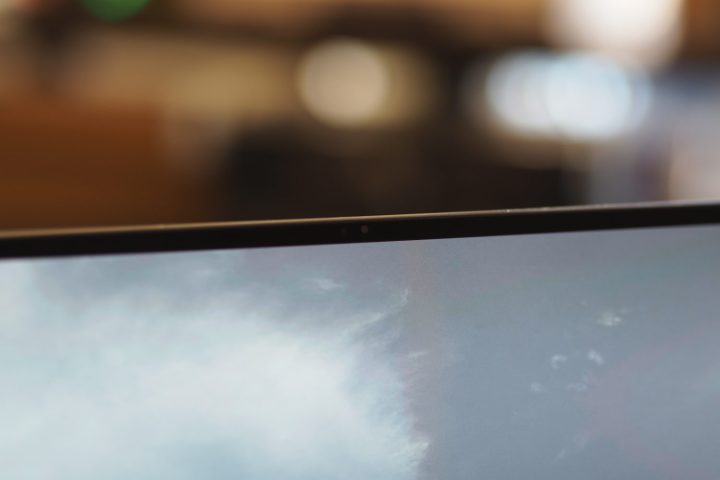
One of the few changes made to the XPS 15 9520 outside of the chipset is splitting the webcam and infrared camera into two components. That improves the webcam’s image quality, although it retains the previous model’s 720p resolution — which is behind the times as more laptops are equipped with Full HD webcams.
Windows Hello passwordless login is provided by an infrared camera and facial recognition and a fingerprint reader embedded in the power button, just where it should be. Both methods worked perfectly.
Battery life
As with the previous generation, the XPS 15 9520 packs in 86 watt-hours of battery capacity to power high-end components and a high-resolution OLED display. Some 15-inch laptops have larger batteries, but the XPS 9510 did well with the same size battery and the same display, so I was interested in seeing the 12th-gen Intel CPU’s efficiency.
We don’t have many comparable Core i7-12700H laptops in our database yet, so direct comparisons are difficult. Nevertheless, we can see that the XPS 15 9520 improved efficiency over the XPS 15 9510, particularly in the PCMark 10 Applications battery test that’s the best indication of typical productivity battery life. In our web browsing test that cycles through several popular and complex websites, the XPS 15 9520 did quite well at 9.5 hours, and its 12.75 hours in our video test that loops a local Full HD Avengers trailer was also a solid showing. Its 11.25 hours in the PCMark 10 Applications test was above average across our entire database.
| Web browsing | Video | PCMark 10 Applications |
|
| Dell XPS 15 9520 (Core i7-12700H) |
9 hours, 38 minutes | 12 hours, 40 minutes | 11 hours, 14 minutes |
| Dell XPS 15 9510 (Core i7-11800H) |
9 hours, 4 minutes | 11 hours, 18 minutes | 8 hours, 3 minutes |
| MSI Creator Z17 (Core i7-12700H) |
4 hours, 23 minutes | 4 hours, 32 minutes | N/A |
| Asus ZenBook Pro 14 Duo (Core i7-12700H) |
3 hours, 10 minutes | 5 hours, 18 minutes | N/A |
| Lenovo Slim 7 16 Pro (Ryzen 7 5800H) |
8 hours, 5 minutes | 11 hours, 48 minutes | 9 hours, 34 minutes |
| LG Gram 16 2-in-1 (Core i7-1260P) |
11 hours, 31 minutes | 17 hours, 58 minutes | 16 hours, 39 minutes |
Battery life was strong for a laptop with a large, power-hungry OLED display and fast components. You’ll get a full day of work unless you push the CPU and GPU, with a little left over. And if your workflow is demanding, you’ll still get far longer on a charge than most laptops with this kind of power. Given that the XPS 15 9520 differs only in its 12th-gen chipset from the previous model, it’s fair to say that Intel’s newest is at least a bit more efficient.
Price and configurations
My review configuration with a Core i7-12700H, 16GB of DDR5 RAM, a 512GB PCIe 4 solid-state drive (SSD), the Nvidia GeForce RTX 3050 Ti, and the 3.5K OLED display costs $2,253 on Dell’s website. You can drop down to a 12-core (four Performance and eight Efficient) Core i5-12500H, 8GB of RAM, a 512GB SSD, Intel UHD graphics, and a Full HD+ (1920 x 1200) IPS non-touch display for $1,420. Max out the XPS 15 9520 with a Core i9-12900HK, 32GB of RAM, a 2TB SSD, the RTX 3050 Ti, and the OLED display, and you’ll pay a hefty $3,037. You can mix and match using Dell’s configurator and pick a machine that fits your needs and minimizes the price — but no matter what you choose, you’ll be firmly in premium laptop territory.
Our take
The Dell XPS 15 9520 picks up where its predecessor left off, retaining its best qualities and increasing performance. It’s a laptop that knows exactly what it wants to be — it’s not the fastest 15-inch laptop, nor is it the thinnest, but it’s the best combination of size and performance you can buy.
You’ll love the build quality, adore the look, and appreciate the display. Yes, you’ll spend some extra cash compared to some competition, but the investment is well worth it. Dell paid attention to the details and engineered not only the best 15-inch laptop but one of the best laptops, period.
Are there any alternatives?
I’m not aware of any laptop as small, thin, and light as the XPS 15 9520 while still offering a 45-watt CPU and a discrete GPU. And lately, 16-inch laptops seem to have become more popular than 15-inch options, just like 14-inch laptops seem to be arriving more quickly than new 13-inch models. So, finding a strong alternative to the XPS 15 9520 in the 15-inch class is difficult.
If you don’t mind jumping up 0.6 inches in screen size, then a 16-inch laptop like the new HP Envy 16 is a good option. Similarly configured but with a lower-res IPS 120Hz display, it’s a few hundred dollars less. It’s not as thin or as light, but the HP Envy 15 was one of our favorite laptops when we reviewed it a couple of years ago, and the newest model seems to uphold the same traditions.
If your budget allows it, you could consider the Apple MacBook 16-inch. It’s equally well built, incredibly fast with its Apple M1 Pro or M1 Max, and it easily offers the best battery life you’ll find in a larger laptop. If you’re not married to Windows 11, the MacBook Pro 16 makes a solid choice.
How long will it last?
The XPS 15 9520 is as well-built as a laptop can be, with attention paid to the fine details and solidity that few laptops can match. It will last for years of productive service, and it’s user-upgradeable as well — increase the RAM up to 64GB and add a second SSD for RAID performance or extra storage. Of course, we’d love to see a longer warranty than a single year, but that’s just how it is with even premium laptops.
Should you buy it?
Yes. If you’re looking for a 15-inch laptop that successfully walks a fine line between portability and performance, you won’t find a better option.
Editors' Recommendations
- Windows 10 Home vs. Pro vs. S mode: What’s the difference?
- Windows 12: the top features we want to see in the rumored OS
- The best gaming PCs for 2023: Dell, Origin, Lenovo, and more
- PC gamers are flocking to Windows 11, new Steam survey says
- The best desktop computers for 2023: Dell, HP, Apple, and more







